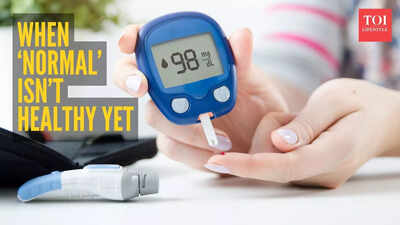ARTICLE AD BOX

For years, people have assumed that as long as their fasting glucose levels, post-meal levels, and HbA1c look normal, they are a safe distance away from diabetes. But in clinical practice, an increasingly large group of individuals with perfectly normal reports are turning out to be at high risk.
It is this early stage, informally termed ‘pre-pre-diabetes’, where metabolic dysfunction begins long before any rise in glucose levels. It is not a recognized diagnostic category as yet, but it reflects a real phenomenon that doctors are now seeing routinely: the body is fighting to keep glucose stable, and on the surface, it succeeds, but underneath, insulin pathways are already failing. Here's everything we need to know as explained by Dr Saptarshi Bhattacharya, senior consultant, endocrinology, Indraprastha Apollo Hospitals.
Prediabetes is just your body's warning bell, he added, saying the pancreas is working extra hard at this stage. Your glucose levels appear normal only because your body is secreting extra insulin to compensate. Yet this struggle doesn't show up in routine tests, and so many people falsely believe they're healthy. During this phase, fasting insulin rises, visceral fat builds up, triglycerides may spike, and inflammation starts to simmer-but your glucose readings remain within limits.
The outward picture looks normal, yet metabolically, the body's already stressed.This mismatch of normal blood glucose but underlying dysfunction is driven by genetics, high-carb diets, long sitting, physical inactivity, and poor sleep. A person can have good HbA1c but still carry significant internal risk. Many people with normal glucose profiles struggle with constant fatigue, post-meal sleepiness, sugar cravings, belly fat, frequent mood dips, skin darkening around the neck (acanthosis nigricans), or struggling to lose weight.
Usually, these symptoms get ignored as a part of routine tiredness or lifestyle issues, which in many cases can be the early signs of insulin resistance.

It is now perceived that insulin resistance is the fundamental engine that drives metabolic syndrome, PCOS, fatty liver, prediabetes, and eventually Type 2 diabetes. When insulin stays high for years, cells stop responding to it, and to compensate, the pancreas releases even more.
This silent cycle keeps getting stretched. By the time blood glucose levels finally start rising, the process has already been going on for eight to ten years.
This is why young Indians in their twenties and thirties, with a normal BMI, are increasingly getting diagnosed with fatty liver and metabolic syndrome when they have no abnormal glucose level readings.Doctors now recommend a deeper look for anyone with a family history of diabetes, weight issues, PCOS, thyroid concerns, sedentary jobs or chronic stress.
Glucose parameters in prediabetes range, minor changes in lipid profile, elevated liver enzymes, high-sensitivity CRP, and fatty liver on ultrasound should not be ignored and may reflect early signs of internal metabolic derangement. Even simple measures such as waist circumference, waist-to-height ratio or a body composition scan may uncover high visceral fat behind an outwardly slim frame.
If we test glucose levels alone, we miss the full story. But if we assess insulin and inflammation early, we can prevent diabetes before it begins.The most promising part is that pre-diabetes is reversible with consistent lifestyle changes. Prioritizing protein in every meal, upping greens and fibre, cutting back on refined carbs and packaged foods, and choosing millets, dals, nuts, and healthier fats help stabilize insulin. Strength training is often ignored, but the biggest user of glucose is muscle tissue, and so building muscle mass can, therefore, greatly improve insulin sensitivity.
The regular movement counts, too; even a short 10–15-minute walk after meals will reduce glucose spikes and thereby reduce insulin demand. Better sleep, stress control techniques, hydration, and reduction of late-night eating further strengthen metabolic resilience.Normal blood glucose levels do not automatically mean normal metabolic health. Prediabetes is the stage where we can make the biggest impact. If we catch insulin resistance early and correct it, we can avoid future diabetes rather than just manage it later. In a country with rising lifestyle diseases, understanding this early, hidden phase may be one of the most powerful tools in changing long-term health outcomes.

 1 hour ago
4
1 hour ago
4








 English (US) ·
English (US) ·